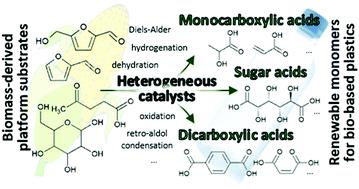当前位置:
X-MOL 学术
›
Chem. Soc. Rev.
›
论文详情
Our official English website, www.x-mol.net, welcomes your
feedback! (Note: you will need to create a separate account there.)
Advances in catalytic routes for the production of carboxylic acids from biomass: a step forward for sustainable polymers.
Chemical Society Reviews ( IF 40.4 ) Pub Date : 2020-07-13 , DOI: 10.1039/d0cs00177e J Iglesias 1 , I Martínez-Salazar 2 , P Maireles-Torres 3 , D Martin Alonso 4 , R Mariscal 2 , M López Granados 2
Chemical Society Reviews ( IF 40.4 ) Pub Date : 2020-07-13 , DOI: 10.1039/d0cs00177e J Iglesias 1 , I Martínez-Salazar 2 , P Maireles-Torres 3 , D Martin Alonso 4 , R Mariscal 2 , M López Granados 2
Affiliation

|
Polymers are ubiquitously present in our daily life because they can meet a wide range of needs and fields of applications. This success, based on an irresponsible linear consumption of plastics and the access to cheap oil, is creating serious environmental problems. Two lines of actions are needed to cope with them: to adopt a circular consumption of plastics and to produce renewable carbon-neutral monomers. This review analyses the recent advances in the chemocatalytic processes for producing biomass-derived carboxylic acids. These renewable carboxylic acids are involved in the synthesis of relevant general purpose and specialty polyesters and polyamides; some of them are currently derived from oil, while others can become surrogates of petrochemical polymers due to their excellent performance properties. Polyesters and polyamides are very suitable to be depolymerised to other valuable chemicals or to their constituent monomers, what facilitates the circular reutilisation of these monomers. Different types of carboxylic acids have been included in this review: monocarboxylic acids (like glycolic, lactic, hydroxypropanoic, methyl vinyl glycolic, methyl-4-methoxy-2-hydroxybutanoic, 2,5-dihydroxypent-3-enoic, 2,5,6-trihydroxyhex-3-enoic acids, diphenolic, acrylic and δ-amino levulinic acids), dicarboxylic acids (2,5-furandicarboxylic, maleic, succinic, adipic and terephthalic acids) and sugar acids (like gluconic and glucaric acids). The review evaluates the technology status and the advantages and drawbacks of each route in terms of feedstock, reaction pathways, catalysts and economic and environmental evaluation. The prospects and the new research that should be undertaken to overcome the main problems threatening their economic viability or the weaknesses that prevent their commercial implementation have also been underlined.
中文翻译:

从生物质生产羧酸的催化路线的进展:可持续聚合物的进步。
聚合物在我们的日常生活中无处不在,因为它们可以满足广泛的需求和应用领域。这种基于不负责任的塑料线性消耗和廉价石油的成功正在造成严重的环境问题。需要采取两条行动来应对这些问题:采用塑料的循环消费和生产可再生的碳中性单体。本综述分析了生产生物质衍生的羧酸的化学催化工艺的最新进展。这些可再生羧酸参与相关通用和特种聚酯和聚酰胺的合成;其中一些目前源自石油,而另一些则由于其优异的性能而可以成为石化聚合物的替代品。聚酯和聚酰胺非常适合解聚为其他有价值的化学品或其组成单体,这有利于这些单体的循环再利用。本综述包括不同类型的羧酸:一元羧酸(如乙醇酸、乳酸、羟基丙酸、甲基乙烯基乙醇酸、甲基-4-甲氧基-2-羟基丁酸、2,5-二羟基戊-3-烯酸、2,5、 6-三羟基己-3-烯酸、二酚酸、丙烯酸和 δ-氨基乙酰丙酸)、二羧酸(2,5-呋喃二甲酸、马来酸、琥珀酸、己二酸和对苯二甲酸)和糖酸(如葡萄糖酸和葡糖二酸)。综述从原料、反应路径、催化剂以及经济和环境评价等方面评价了各路线的技术现状和优缺点。 还强调了为克服威胁其经济可行性的主要问题或阻碍其商业实施的弱点而应进行的前景和新研究。
更新日期:2020-08-17
中文翻译:

从生物质生产羧酸的催化路线的进展:可持续聚合物的进步。
聚合物在我们的日常生活中无处不在,因为它们可以满足广泛的需求和应用领域。这种基于不负责任的塑料线性消耗和廉价石油的成功正在造成严重的环境问题。需要采取两条行动来应对这些问题:采用塑料的循环消费和生产可再生的碳中性单体。本综述分析了生产生物质衍生的羧酸的化学催化工艺的最新进展。这些可再生羧酸参与相关通用和特种聚酯和聚酰胺的合成;其中一些目前源自石油,而另一些则由于其优异的性能而可以成为石化聚合物的替代品。聚酯和聚酰胺非常适合解聚为其他有价值的化学品或其组成单体,这有利于这些单体的循环再利用。本综述包括不同类型的羧酸:一元羧酸(如乙醇酸、乳酸、羟基丙酸、甲基乙烯基乙醇酸、甲基-4-甲氧基-2-羟基丁酸、2,5-二羟基戊-3-烯酸、2,5、 6-三羟基己-3-烯酸、二酚酸、丙烯酸和 δ-氨基乙酰丙酸)、二羧酸(2,5-呋喃二甲酸、马来酸、琥珀酸、己二酸和对苯二甲酸)和糖酸(如葡萄糖酸和葡糖二酸)。综述从原料、反应路径、催化剂以及经济和环境评价等方面评价了各路线的技术现状和优缺点。 还强调了为克服威胁其经济可行性的主要问题或阻碍其商业实施的弱点而应进行的前景和新研究。











































 京公网安备 11010802027423号
京公网安备 11010802027423号